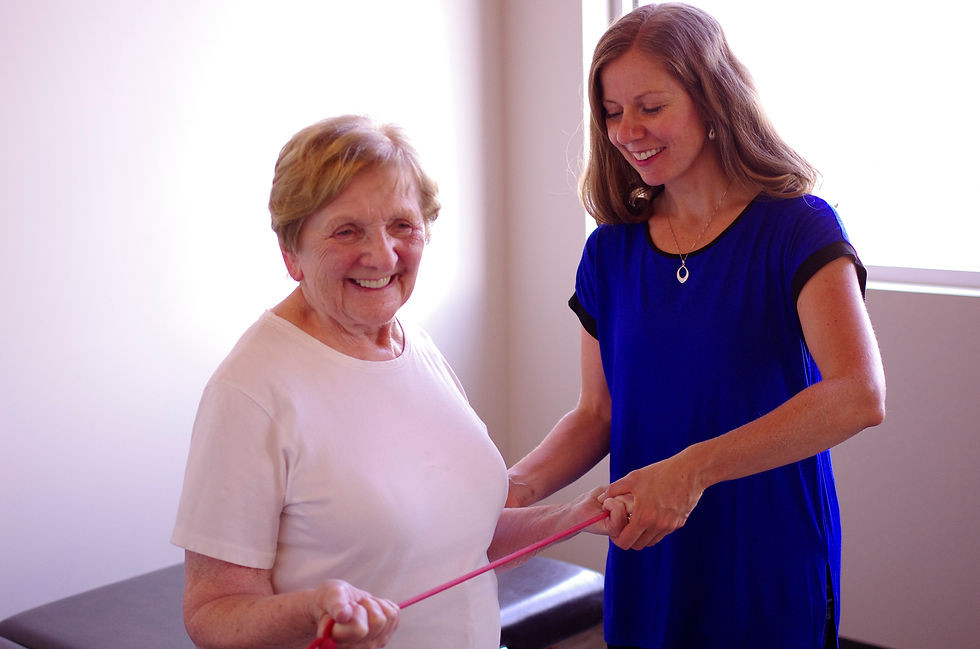Mind Your Movement: Pilates and Stroke Recovery
- Lisa Mills-Hutton BMR(PT), B.Comm(Hons)
- Feb 6, 2018
- 4 min read
Updated: Apr 14, 2022
by Lisa Mills-Hutton, Physiotherapist

“Movement is a medicine for creating change in a person’s physical, emotional and mental states.” Carol Welch
As a physiotherapist I use Pilates exercises and/or the Pilates reformer with most of my patients at some point in their treatment plan, especially with patients who have had a traumatic brain injury, stroke and other neurological conditions. Why?
The Pilates reformer allows the therapist to provide adequate postural support to enable appropriate alignment and stability of the trunk or limbs, therefore reducing the fear of falling, compensatory fixation or recruitment of inappropriate muscles. The Pilates reformer has hundreds of exercises plus unlimited number of modifications and propping to assist the patient to reach their treatment goals. Hands on facilitation can be utilized to encourage the patient to move in a functional pattern and avoid compensatory strategies. Visual imagery and focused breathing is also used to further develop mind- body awareness for the patient.
From the patient perspective they often give me some sort of horrifying look when I show them the Pilates reformer and explain I want to use the machine as part of their treatment plan. They joke and call the reformer names that I will not repeat in this article. Usually after the first session they are hooked, and ask to use the machine on their next treatment session. They really enjoy being able to move their legs and arms with such skill. Imagine being in a wheelchair and allowing your legs to move in a selective pattern or being able to move your hemiplegic leg without the knee hyperextending the moment you try to move it. In 2014 Van Der Linden et al. studied fifteen participants with multiple sclerosis who use a wheelchair: to determine feasibility, efficacy and participant experiences. At the end of the12 weeks all patients in the study reported enjoying the classes, improved sitting stability, posture and decreased pain.
There are dozens of research articles discussing the benefits of Pilates, this is how they may help our patients with neurological conditions.
1. Balance: Newell et al. found a decreased anterior-posterior sway along with an improvement in the fall risk index (FRI) after an 8-week once weekly Pilates session with older adults (Newell et al. 2012).
2. Pelvic Alignment: Pilates may contribute in improving proper trunk alignment. Proper alignment is so vital for efficient execution of movements, effective muscle recruitment and assists in the ability to activate the deep stabilizers in the back and pelvis. Pilates gives lots of feedback with the back on the machine, props used by the therapist and when necessary manual handling to encourage ideal alignment. Pilates may help patients increase body awareness and their ability to find neutral alignment (Deckert, 2007 & Cruz-Ferriera, Ana et al. 2013).
3. Breathing: Pilates’ emphasis on controlled breathing with each movement boosts physical efficiency by decreasing unnecessary contractions but also facilitates proper alignment in posture (Segal, Hein and Basford, 2004). How many times do we notice patients holding their breath when executing movements?
4. Improving Motor Control and Stability: Pilates emphasizes quality of movement. Instead of doing many repetitions of the same exercise, Pilates encourages fewer repetitions with more precision and care. This is far more ideal than doing the same exercise over and over with faulty muscular patterns. If we are trying to re-educate the brain (i.e. neuroplasticity) the Pilates reformer is another tool to reinforce correct alignment and ideal muscle recruitment. With hemiplegia, there is a strong tendency to shift completely to the less affected side, which only reinforces the weakness and poor motor control of the affected side. As a result, the asymmetry in the physical body becomes reinforced as opposed to moving towards correction. By using Pilates principles to facilitate proper breathing and alignment, they may improve motor control and lumbo-pelvic stability.
5. Neuromuscular Re-education: Pilates promotes neuromuscular re-education in functional positions and planes, while focusing on stabilizing the spine. The benefits of Pilates include the development of strength, flexibility, proprioception, muscle balance and symmetry, balance, control and improved posture and body awareness. The increased strength of the core muscles allows for more efficient movement of the extremities and trunk. Hence, functional activities that require balance and control may be performed more efficiently and safer (Bryan and Hawson, 2003).
With the rapidly changing currents in healthcare, there is an emphasis on rehabilitation programs to focus on educating each patient to be responsible for their own recovery process, regardless of their diagnosis. Each patient needs to understand the recovery process can continue long after their formal rehabilitation programs ends. We are fortunate in Manitoba to have many skilled pilates instructors teaching small group classes. This is an option our patients could explore independently, when and if it is appropriate, to continue to challenge their bodies and maximize their recovery post discharge.
As with most things in the rehabilitation world there needs to be more research in the use of the Pilates reformer and Pilates principles in neurological rehabilitation. For now, it is one more effective tool in our toolkit that patients enjoy utilizing and that assists in improving patient physical outcomes and sense of physical ability.
Lisa

































